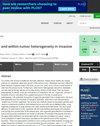标准病毒动态模型中关键参数的估计值有多可靠?
IF 3.6
2区 生物学
引用次数: 0
摘要
对于包括艾滋病病毒、丙型肝炎病毒和乙型肝炎病毒在内的多种导致慢性感染的病原体,人们已经建立了病毒感染的数学模型,并将其与数据进行了拟合,从而对疾病的发病机理有了深入的了解。然而,对于引起急性感染的病原体或在引起慢性感染的病原体的急性期,病毒载量数据通常是在出现症状后收集的,通常是在病毒载量峰值前后。因此,我们经常缺乏病毒生长初期的数据,即无症状前传播事件发生时的数据。缺失的数据可能会给估算感染时间、感染期和病毒动态模型参数(如细胞感染率)带来困难。然而,如果有额外的信息,如病毒载量达到峰值的平均时间,则可以提高估算的稳健性。在此,我们评估了当病毒载量峰值之前的病毒载量数据缺失时,当我们知道某些参数的值和/或从感染到病毒载量峰值的时间时,关键模型参数估计的稳健性。虽然对感染时间的估计对可用数据的质量和数量很敏感,尤其是高峰前的数据,但对了解疾病发病机制很重要的其他参数(如感染细胞的丢失率)则不太敏感。病毒传染性和病毒产生率是影响数据拟合稳健性的关键参数。将它们的值固定为文献值有助于在峰前数据缺失或有限的情况下估计其余模型参数。我们发现,如果缺乏高峰前生长阶段的数据,病毒载量达到峰值的时间就会被低估数天,从而导致预测的生长阶段缩短。另一方面,即使在缺乏早期数据的情况下,知道感染时间(例如从流行病学数据中)并将其固定下来,也能获得良好的动态参数估计。虽然我们提供了在没有早期病毒载量数据的情况下近似估计模型参数的方法,但我们的结果也表明,如果有这些数据,就需要更精确地估计模型参数。本文章由计算机程序翻译,如有差异,请以英文原文为准。
How robust are estimates of key parameters in standard viral dynamic models?
Mathematical models of viral infection have been developed, fitted to data, and provide insight into disease pathogenesis for multiple agents that cause chronic infection, including HIV, hepatitis C, and B virus. However, for agents that cause acute infections or during the acute stage of agents that cause chronic infections, viral load data are often collected after symptoms develop, usually around or after the peak viral load. Consequently, we frequently lack data in the initial phase of viral growth, i.e., when pre-symptomatic transmission events occur. Missing data may make estimating the time of infection, the infectious period, and parameters in viral dynamic models, such as the cell infection rate, difficult. However, having extra information, such as the average time to peak viral load, may improve the robustness of the estimation. Here, we evaluated the robustness of estimates of key model parameters when viral load data prior to the viral load peak is missing, when we know the values of some parameters and/or the time from infection to peak viral load. Although estimates of the time of infection are sensitive to the quality and amount of available data, particularly pre-peak, other parameters important in understanding disease pathogenesis, such as the loss rate of infected cells, are less sensitive. Viral infectivity and the viral production rate are key parameters affecting the robustness of data fits. Fixing their values to literature values can help estimate the remaining model parameters when pre-peak data is missing or limited. We find a lack of data in the pre-peak growth phase underestimates the time to peak viral load by several days, leading to a shorter predicted growth phase. On the other hand, knowing the time of infection (e.g., from epidemiological data) and fixing it results in good estimates of dynamical parameters even in the absence of early data. While we provide ways to approximate model parameters in the absence of early viral load data, our results also suggest that these data, when available, are needed to estimate model parameters more precisely.
求助全文
通过发布文献求助,成功后即可免费获取论文全文。
去求助
来源期刊

PLoS Computational Biology
生物-生化研究方法
CiteScore
7.10
自引率
4.70%
发文量
820
期刊介绍:
PLOS Computational Biology features works of exceptional significance that further our understanding of living systems at all scales—from molecules and cells, to patient populations and ecosystems—through the application of computational methods. Readers include life and computational scientists, who can take the important findings presented here to the next level of discovery.
Research articles must be declared as belonging to a relevant section. More information about the sections can be found in the submission guidelines.
Research articles should model aspects of biological systems, demonstrate both methodological and scientific novelty, and provide profound new biological insights.
Generally, reliability and significance of biological discovery through computation should be validated and enriched by experimental studies. Inclusion of experimental validation is not required for publication, but should be referenced where possible. Inclusion of experimental validation of a modest biological discovery through computation does not render a manuscript suitable for PLOS Computational Biology.
Research articles specifically designated as Methods papers should describe outstanding methods of exceptional importance that have been shown, or have the promise to provide new biological insights. The method must already be widely adopted, or have the promise of wide adoption by a broad community of users. Enhancements to existing published methods will only be considered if those enhancements bring exceptional new capabilities.
 求助内容:
求助内容: 应助结果提醒方式:
应助结果提醒方式:


